The Importance of Ongoing Testing of Ballast Water Management Systems

Most ships subject to the International Maritime Organization (IMO) Ballast Water Management Convention 2004 (BWM Convention) are expected to install a ballast water management system (BWMS) to meet the “performance standard." This regulation in the BWM Convention prescribes the very low concentration of viable (living) organisms that may be discharged with ballast water.
This is the crux of the BWM Convention: the environmentally protective standard to guard against the transfer and delivery of invasive species. While biologists usually group organisms by function or evolutionary history, for practical reasons, organisms in the BWM Convention are binned by size: ≥50 µm (typically zooplankton) and ≥10 µm to <50 µm (typically phytoplankton), plus three bacteria indicators and pathogens.
Models of BWMS must undergo land-based, shipboard, electrical and electronic section, and mechanical testing to ensure they are fit for purpose. Following acceptable performance, a model receives type approval for general installation. Because a type approval certificate cannot account for the variation across ships, vessel-specific commissioning testing is conducted to determine the suitability of the onboard BWMS.
Although the BMW Convention entered into force in 2017, most existing ships’ compliance dates — which are based on the ships’ last renewal survey — are just now drawing near. Thus, BWMS installations have risen steeply in the last two years, and they are expected to peak this year. Until June 1, 2022, there is no requirement following the BWM Convention for commissioning to include biological efficacy testing to determine whether the Convention’s performance standard is met. Notably, a small number of Administrations are “early adopters” and have made testing mandatory at this time, so not surprisingly, most biological efficacy testing has been conducted in those countries (e.g., Australia, Canada, Croatia, Cyprus, France, Greece, India, Singapore, and Tuvalu).
As part of the BWM Convention Experience Building Phase, a robust dataset has been assembled to track trends in BWMS biological efficacy, ease of installation, challenges, etc. Recently, the IMO described data being analyzed from approximately 16,200 ships (submitted by 38 Member States, two port State control memorandums of understanding, and nine other stakeholders). The full report has been submitted to the 78th meeting of the IMO Marine Environment Protection Committee (MEPC 78, MEPC 78/4/1).
From the 660 commissioning tests SGS has conducted, approximately one eighth (13 percent) failed to meet the performance standard. Notably, very nearly all failures occurred in the largest size class (≥50 µm) of organisms.
This suggests several possible scenarios: the BMWS filters failed (since nearly all BWMS use filters to remove the largest organisms), BWMS were installed or operated improperly (triggering critical alarms), the ships’ pipes or tanks were insufficiently cleaned to remove viable organisms, the water pumped into ballast tanks challenged the BWMS’s capabilities (e.g., the turbidity in the uptake water exceeded the BWMS System Design Limitations), or a combination of these scenarios.
Regardless of the cause, these results demonstrate that onboard commissioning testing is necessary to verify the proper working of BWMS in each unique shipboard environment.
It is notable that commissioning testing represents the “best case scenario” in ballast water treatment. That is, the BWMS is new, the crew has recently been trained in the operation of this equipment, and in most cases (69 percent, in SGS’s experience), the vendor’s representative is onboard to troubleshoot any technical problems that arise.
Looking to the future, it will be critical to establish an ongoing, regular testing regime to ensure that BWMS are properly operated, to verify that BWMS sensors are routinely and properly calibrated, to ensure BWMS are properly maintained, and, ultimately, to ensure BWMS continue to work as intended. In summary, ongoing compliance testing is necessary to confirm that BWMS continue to be environmentally protective and the goal of the BWM Convention is met.
The views and opinions expressed in this article are those of the authors and do not necessarily reflect the official policy or position of SGS. Assumptions made within the analysis are not reflective of the position of SGS.
Lisa Drake, PhD previously led the interdisciplinary ballast water research group at the U.S. Naval Research Laboratory in Key West, Florida. Now working for SGS, the world's leading testing, inspection and certification company, Lisa manages marine environmental services in the Americas. She—along with a global team of experts—guides this work in more than 330 ports worldwide, including a newly opened laboratory in Panama.
Guillaume Drillet, PhD is the Regional Manager of SGS for Asia and Oceania Marine Services. He is the Chair of the Global TestNet, an organization with consultative status at the IMO and representing testing organizations as well as Director of the Board of the World Aquaculture Society.
Claudio Gianoli is SGS global Technical Expert for Environmental Health and Safety Services with 35 years of experience working with environmental sciences in the public and private sectors.
Ersi Zacharopoulou, MSc (Eng) is the Development Manager of SGS, Europe, Africa and Middle East Marine Services, and a member of Technical Chamber of Greece.
The opinions expressed herein are the author's and not necessarily those of The Maritime Executive.

